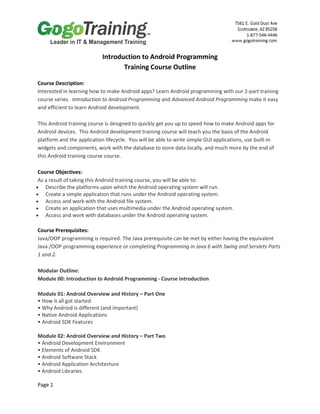Android outline
- 1. Page 1 Introduction to Android Programming Training Course Outline Course Description: Interested in learning how to make Android apps? Learn Android programming with our 2-part training course series. Introduction to Android Programming and Advanced Android Programming make it easy and efficient to learn Android development. This Android training course is designed to quickly get you up to speed how to make Android apps for Android devices. This Android development training course will teach you the basis of the Android platform and the application lifecycle. You will be able to write simple GUI applications, use built-in widgets and components, work with the database to store data locally, and much more by the end of this Android training course course. Course Objectives: As a result of taking this Android training course, you will be able to: • Describe the platforms upon which the Android operating system will run. • Create a simple application that runs under the Android operating system. • Access and work with the Android file system. • Create an application that uses multimedia under the Android operating system. • Access and work with databases under the Android operating system. Course Prerequisites: Java/OOP programming is required. The Java prerequisite can be met by either having the equivalent Java /OOP programming experience or completing Programming in Java 6 with Swing and Servlets Parts 1 and 2. Modular Outline: Module 00: Introduction to Android Programming - Course Introduction Module 01: Android Overview and History – Part One • How it all got started • Why Android is different (and important) • Native Android Applications • Android SDK Features Module 02: Android Overview and History – Part Two • Android Development Environment • Elements of Android SDK • Android Software Stack • Android Application Architecture • Android Libraries
- 2. Page 2 • Lab Exercise: Initial Configuration of the Android SDK Module 03: Android Stack • Overview of the stack • Linux kernel • Native libraries • Dalvik • App framework • Apps • Lab Exercise: Configure Initial Application, Run in Emulator Module 04: SDK Overview • Platforms • Tools • Versions • Lab Exercise: Download and Create in Android Virtual Device Manager Module 05: Hello World App • Creating your first project • The manifest file • Layout resource • Running your app on Emulator • Lab Exercise: Create, Compile and Run 'Hello, Android' App Module 05a: Hello World App Demo Module 06: Main Building Blocks • Activities • Activity lifecycle • Intents • Services • Content Providers • Broadcast Receivers • Lab Exercise: Review Activities, Intents, and Content Providers Module 06a: Main Building Blocks Demo Module 07: Basic Android User Interface • XML versus Java UI • Dips and sps • Views and layouts • Common UI components • Handling user events • Lab Exercise: Create Application with onClick, onKeyDown, onFocusChanged Event Handlers
- 3. Page 3 Module 07a: Basic Android User Interface Demo Module 08: Android System Overview • File System • Preferences • Notifications • Security model • Lab Exercise: Create Application with Toast Notifications Module 09: Advanced Android User Interface – Part One • Selection components • Adapters • Complex UI components • Building UI for performance Module 10: Advanced Android User Interface – Part Two • Menus and Dialogs • Graphics • Animation • Lab Exercise: Create Application with Android's Advanced User Interface Functions Module 10a: Advanced Android User Interface Demo Module 11: Multimedia in Android • Multimedia Supported audio formats • Simple media playback • Supported video formats • Simple video playback • Lab Exercise: Create Android Audio/Video Application Module 11a: Multimedia in Android Demo Module 12: SQL Database • Introducing SQLite • SQLiteOpenHelper and creating a database • Opening and closing a database • Working with cursors Inserts, updates, and deletes • Lab Exercise: Create Application to Create, Modify and Query an SQLite Database
- 4. Page 4 Module 12a: SQL Database Demo Module 13: Basic Content Providers • Content provider MIME types • Searching for content • Adding, changing, and removing content • Working with content files • Lab Exercise: Create Application that Works with an Android Content Provider Module 13a: Basic Content Providers Demo Module 14: Data Storage, Retrieval and Sharing • Android Techniques for Saving Data • Saving Simple Application Data • Creating and Saving Preferences • Retrieving Shared Preferences • Saving Activity State • Creating a Preferences Page • Saving and Loading Files • Lab Exercise: Create application that performs Data Storage and Retrieval from Android External Storage Module 15: Mapping and Location Based Services • Using Location Based Services • Setting up your Emulator with Location Based Services • Selecting a Location Provider • Finding Your Location • Using Proximity Alerts • Using the Geocoder • Creating MapBased Activities • Lab Exercise: Create Location-Aware application that uses Proximity Alerts and Google Maps API Module 15a: Mapping and Location Based Services Demo Module 16: Working in the Background • Introducing Services • Using Background Worker Threads • Introducing Notifications • Using Alarms • Lab Exercise: Create application with One-Time, Repeating Alarms, and Long-Running Background Task as Service Module 16a: Working in the Background Demo




